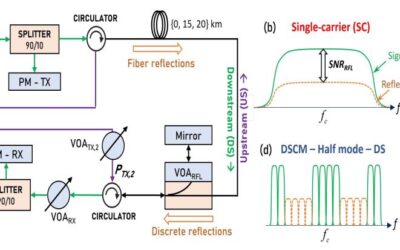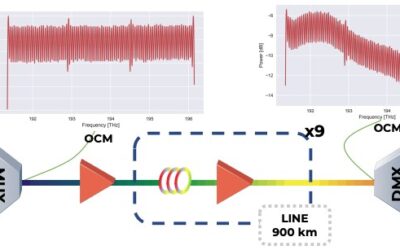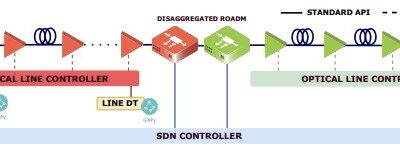About ALLEGRO ‘Agile ultra low energy secure networks’
 ALLEGRO aims at designing and validating a novel end-to-end sliceable, reliable, and secure architecture for next-generation optical networks, achieving high transmission/switching capacity
ALLEGRO aims at designing and validating a novel end-to-end sliceable, reliable, and secure architecture for next-generation optical networks, achieving high transmission/switching capacity
- with 10 Tb/s for optoelectronic devices and 1 Pbt/s for optical fiber systems
- low power consumption/cost
- with > 25% savings
- and secure infrastructures and data transfers.
The architecture relies on key enabling innovations:
- smart, coherent transceivers exploiting multi-band & multi-fiber technologies for P2P and P2MP applications, based on e.g., high-speed plasmonic modulators/photodetectors and programmable silicon photonic integrated waveguide meshes;
- loss-less, energy-efficient transparent photonic integrated optical switches, eliminating OEO conversions, e.g., with on-chip amplification in the O-band for datacom applications;
- a consistent approach to security, in terms of functional/ protocol architectures and communications, further improving QKD systems, enabling optical channel co-existence and researching on quantum-resistant (post-quantum) cryptography, developing systems based on physically unclonable functions; and
- a scalable AI/ML assisted control and orchestration system, responsible for autonomous networking, dynamic and constrained service provisioning, function placement and resource allocation, leveraging devices increasing programmability and overall network softwarization.
To achieve the target objectives and KPIs, ALLEGRO has defined a clear methodology ending in ambitious demonstrators. The consortium includes a good balance of industry and research/academia with know-how in complementary fields.
The results of ALLEGRO will be disseminated in leading conferences, events, and high-impact journals. They will have a concrete and measurable economic and social impact, contributing towards achieving key European objectives, reinforcing European leadership and digital sovereignty in the ongoing digital and green transition.
Project News
Bidirectional Transmission Modelling in Real-Time
Excited to share our latest work on Bi-Di transmission between two 400G-capable coherent transceivers (TRXs) over a single fibre at 193.0 THz! This setup enables both upstream (US) and downstream (DS) channels to share the same center frequency, pushing the boundaries...
Digital Twin Implementation with Commercial Equipment in Optical Networks
The key to realizing Digital Twins (DTs) in optical networks lies in accurately modeling critical network components—particularly transceivers and optical amplifiers. These components significantly impact the reliability and predictive capabilities of DT frameworks. 📌...
DT-assisted Self-Healing in Partially Disaggregated Networks
We're excited to share our latest work in the ALLEGRO project on Digital Twin (DT) assisted Self-Healing! 🌐✨ By leveraging the open-source GNPy library (by TIP) as a digital model service, we've implemented a DT-driven Optical Line Controller (OLC) capable of...
Hammerstein-Wiener System-Based Nonlinear Model for Chirp Compensation
Excited to share my latest work on chirp compensation using a nonlinear model (NLM) to mitigate the effects of directly modulated VCSELs (DMVCSELs)! By leveraging a Hammerstein-Wiener (HW) system, our trained model utilizes a phase modulator (PM) to correct phase...
BVT Modelling with VCSEL Chirp Dynamics
DM VCSELs (Directly Modulated Vertical-Cavity Surface-Emitting Lasers) are at the core of high-speed optical communication systems, offering compact size and high performance. To enhance the efficiency of Bandwidth-Variable Transmitters (BVTs), we developed a model...
Advancing Bandwidth Variable Transceivers (BVTs) in ALLEGRO
In the ALLEGRO project we are pushing the boundaries of VCSEL-based Bandwidth Variable Transceivers (BVTs) with advanced chirp compensation techniques. Our work focuses on optimizing the performance and adaptability of SDN-enabled S-BVTs through adaptive digital...
Advancing Power-Efficient E2E Transport Infrastructure
In the ALLEGRO project we are pioneering next-generation flexible transceivers (TRXs) to optimize optical communication networks. A key aspect of our work is the back-to-back (B2B) characterization of coherent TRXs, enabling precise assessment of light-path GSNR...
Optimizing Optical Amplifiers for Multi-Band Transmission
As optical networks scale beyond the C+L bands, the role of optical amplifiers (OAs) becomes increasingly critical. While Erbium-Doped Fiber Amplifiers (EDFAs) remain the go-to solution for C and L bands, extending amplification further requires new rare-earth...
Exploring the Impact of MB Loss Profile and SRS on GSNR
In our latest study, we dive deep into the effects of Stimulated Raman Scattering (SRS) on multi-band optical transport. Looking we analyze the GSNR and its OSNR and SNR_NL components for a 70 km scenario, revealing key insights: 🔹 Without SRS (dot-dashed curves), the...
Optical Transport Digital Model in PHY-DT
In optical networking, the transport system consists of transparent WDM light paths (LPs) that need to be optimized across the network topology. A key challenge in modeling these paths is accounting for signal impairments caused by nonlinear fiber effects, amplified...



